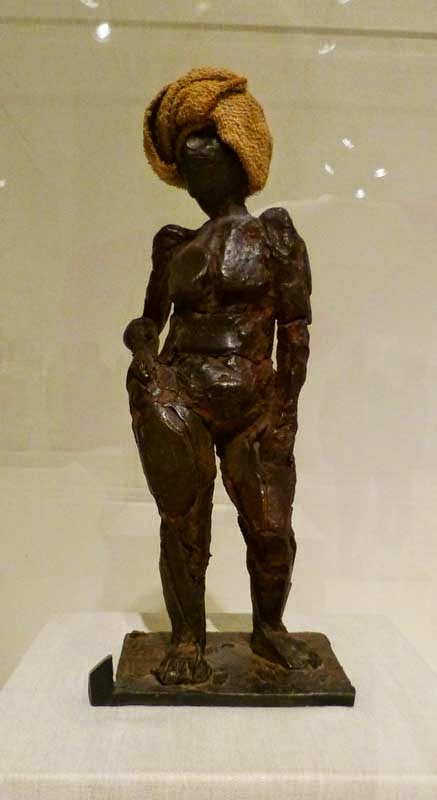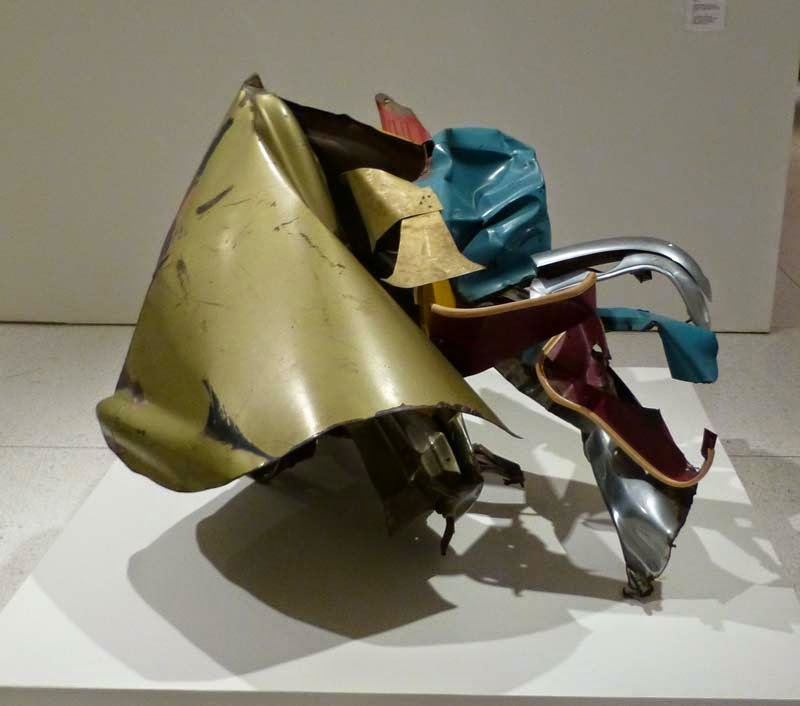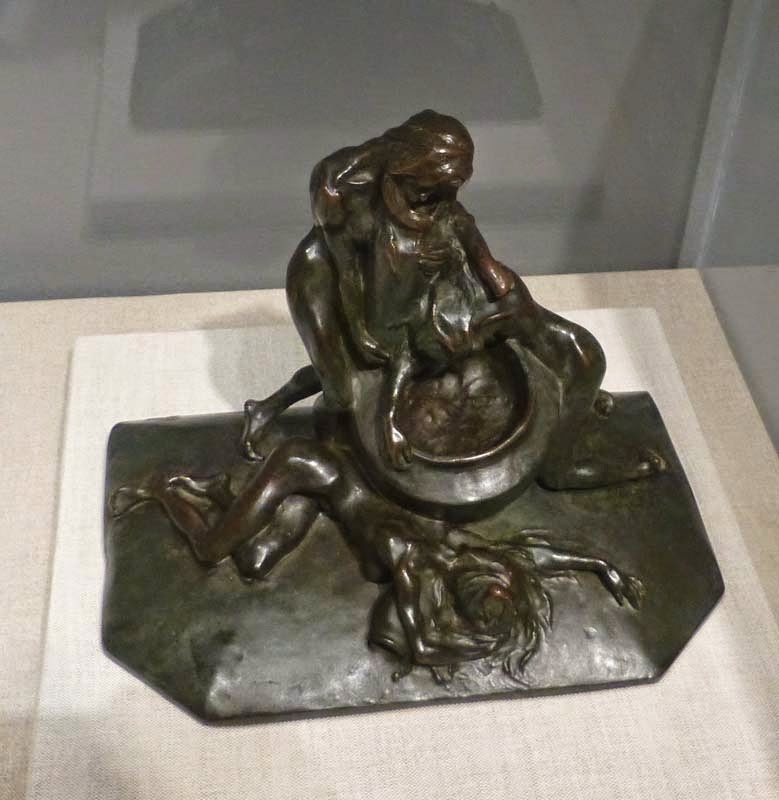Smart Museum: What is Sculpture ?
George Minne, "Kneeling Youth"
What makes an object a sculpture ?
In an artworld where breaking boundaries is the rule, rather than the exception, we might better ask "who decides an object is called a sculpture?"
Millions of Brillo boxes on supermarket shelves do not qualify -- but one of them may be called "sculpture" if put on display in an art museum.
Nevertheless, this exhibition encourages viewers to examine their own experiences to seek the answer, led by a group that calls itself "500 Clown".
"We invite you to move from passive visitors in the galleries to active participants in co-creating the Museum." say the clowns -- but this "co-creation" of the museum is only in the mind. It is no more active than any other act of looking.
The Good, Bad, Ugly exhibit at the DePaul Museum a few years back was a more sincere invitation for participation, offering explanations for why some pieces were being considered for de-acquisition, and asking viewers to vote their responses.
Who now cares "what are the essential qualities that define sculpture"? - when such a definition has become progressively more difficult over the years. ?
Apparently academic curators still do. This review written by a curator from the Block Museum tells how each gallery opens another "path of inquiry", and attempts to revive the controversies of early 20th C. Modernism by claiming that the gallery which shows that work "errs heavily on the side of tradition." Though such a controversy itself is a century old tradition by now.
***************
This post is my form of viewer participation - beginning with the sculpture shown above --- because it's one of my favorites in the Smart museum's collection, though it was not included in this show.
David Hare, 1955 .......... Marino Marini, 1956
Mainstream figure sculpture fled from any sense of social idealism in the 1950's -- and I'm not fond of it.
But the Smart can fill an entire small gallery with this genre -- and it's interesting to see these pieces side by side.
Eduardo Paolozzi., 1956 ........................ David Hare, 1955
Richard Hunt, 1961
This youthful Richard Hunt piece looked pretty good in the same room -- and it felt quite figurative - and jaunty.
Anthony Caro, 1984
Germaine Richier, 1955
Henry Moore
Moving over to something quite different - this case offers an interesting juxtaposition of Art Deco neo-Egyptian (made by an Armenian) --- with a piece made by an actual contemporary Egyptian.
Mahmud Mukhtar, 1930
The stillness and power of ancient Egyptian sculpture is apparently being sought - but not being achieved.
Hakop Gurdjian, 1930's
This piece is more pleasantly decorative -- but still feels 5,000 years removed from the Old Kingdom.
This man is not an ancient Egyptian - he's an extra in a Hollywood movie set in ancient Egypt.
Fang peoples (Cameroon), Byeri (male ancestor figure)
The museum does not seem to have much African sculpture -- is this the only piece ?
As sculpture, it hardly compares with the Great Bieri at the Met.
If you wish to distinguish cultural artifacts from sculpture, this is the former.
Emil Armin, 1923
This local artist is much better known as a painter - but this is respectable venture into a very different medium. And formally it has more in common with ancient Egyptian sculpture than the attempted imitations shown earlier in this post.
Hans Arp
These small pieces are much less impressive than the large-scale piece up in Evanston, just outside the Block Museum. I'd rather just look at gourds.
If I were going to define "sculpture",
I would use this display case as an example.
The two Buddhas to the left (Chinese and Tibetan) are just Buddhas.
But the small, green one to the right (Korean)
is also a sculpture.
Korea, Amita Buddha, 15th C.
Quite delightful, actually.
John Chamberlin, 1963
Not that similar conglomerations could not be found in any junk yard -- but still, I like this one.
It feels like it's been composed as an ebullient ornamental riff - doing the same thing with fragments of colored metal that other ABX artists were doing with gobs of paint.
Charpentier, inkwell ("Starvation"), 1894
The Smart has several cases full of 19th C. bronzes - most of which should be sold for scrap and then melted down.
But this one has some very delicate modeling.
And it's also a bit strange.
Who would want to be reminded of starving people whenever dipping one's pen into ink ?
Wonderfully modeled hips
The Smart has a substantial collection of historic Chinese painting-- but it's Tang sculpture is not worth keeping.
Better examples can be seen every year at the Chicago Antiques Fair.
Jacques Lipschitz, death mask of Modigliani
Lipschitz was a great sculptor -- and Modigliani a great painter.
But a death mask is just a cast taken from a corpse.
Why is this in a collection of sculpture ?
A nice little bust by Rodin.
It appears to be a 20th century homage to ancient work - so appropriately enough, it shared a display case with some ancient artifacts.
I'm guessing that this small torso, with the Three Graces, is 4th C. Roman
Pierre-Philippe Thomire (1758-1843)
Thomire was the leading ornamental sculptor of his time - reportedly employing 700 workers in his factory in Paris.
The three dancing figures aren't quite as special as the low relief around the base.
But I doubt we'll ever know who actually modeled it.
Egide Rombaux, "Mountain of Venus" (Venusberg), c. 1900
Elsewhere I have written a little tribute to this sculptor.
I enjoy his favorite theme of rampant hetero-sexuality - but this piece feels a bit cluttered.
The rest of this case is forgettable
Pakistan was a great place for figure sculpture - 400 years before it was over run by Muslim armies.
These examples are mediocre - but still worth seeing.
Most of the Ghandaran sculpture that I've seen was carved stone -- but Gallery signage tells us that this piece is cast stucco.
A small tribute to the Chicago Imagists
Princess Marie Christine D'Orleans, "Joan of Arc", 1835
It's fascinating that a young daughter of King Louis-Philippe was a serious student of sculpture,
but this piece is little more than an historical curiosity.
John Mowbray-Clark, 1918
I'd like to see more work from this artist, who was a principal organizer of the 1913 Armory Show.
Joseph Charles Marin, 1788
A bit more cute than his master, Clodion, I'm still glad to be introduced to this 18th C. sculptor.
Jacques Lipschitz, 1914
This is another piece from the Joel Starrels Jr. Memorial Collection of bookshelf sized early 20th C. modernist sculpture.
Magdalena Abakanowicz
Magdalena's sculpture is pretty much focused on the misery of life in 20th C. central Europe.
Her parade of rusting headless iron zombies doesn't really belong in Chicago's Grant Park -- but this dreary, sexy, outrageous monumental fabric would make a darkly humorous addition to the wall of some condo overlooking the lake.
Maillol
Happily, this piece is usually on display as one enters the museum -- and I'm always glad to see it.
Avant Garde Modernism only flirted briefly with Classicism before launching itself into a century (or more) of surrealist rebellion.
Zhan Wang, "Ornamental Rock", 1996
For at least a thousand years, maybe longer, every Chinese Mandarin's courtyard had to have a "scholar's rock" --- i.e. a big chunk of weathered stone whose turbulent forms suggest the forces of nature.
Several contemporary Chinese artists have continued this tradition by making their own.
Several monumental pieces were displayed on the roof of the ModernWing last year -- and other pieces have recently shown up on temporary display in Millennium Park.
This piece, which resembles crumpled tin foil - is pleasant enough -- but it doesn't really demonstrate the power that real geological specimens - or really good sculpture - can display.
Here's another interesting juxtaposition -- placing an ancient Cambodian Shiva Linga next to two pieces of modern sculpture.
Han Yongjin, "Dark Black Stone", 1986
Yong Jin Han is something of a minimalist,
but this is the kind of minimalism I enjoy
The piece feels relaxing rather than annoying.
Isamu Noguchi, "Goddess", 1982
My photograph does not do justice
to the flecked surface of this
gently mysterious and humorous piece.
I suppose if it had a protrusion instead of a hole in the center,
Noguchi would have called it a "God"
Dan Peterman, 2005
If the Smart collection has to include joke art,
it might as well have these tubs of abandoned laboratory equipment,
appropriate for its university setting.
Rodin "Despair", modeled 1880-1890, this cast made in 1956
The legacy of Rodin has been carved, re-cast, scaled up, and scaled down for over a hundred years, often with regrettable results
This is a nice little piece, cast long after the artist had died.
On the other hand, this reduction of his "John the Baptist"
may have been cast in 1878,
but it is a faint memory of the dynamic, larger-than-life version
modeled in 1877.
Like items sold in the gallery of its promised donor, Richard Gray,
it certainly is collectible on the basis of its pedigree.
But it's quite disappointing to look at.
Roman, 2nd Century,
"Youth in a Phrygian Hat feeding a Griffin"
A rather wacky subject matter:
apparently Griffins were known to guard hordes of gold,
so ambitious treasure hunters would offer them food
to distract attention.
A small, but nice fragment.
Nick Cave
Why is a Nick Cave "Sound Suit" in an encyclopedic art museum,
while Hollywood or Mardi Gras costumes are not ?
It's all about marketing.
Looking at such things
will not provide an answer.
This one reminds me a lot
of the tribal costumes from the South Pacific
shown at the Field Museum.
John Storrs (1885-1956)
Storrs was our local amateur Modernist,
and a very good one.
His pieces seem to have that interior steel spring
that makes them feel full of potential energy.
I wish these bronzes could have been shown outside their glass cases.
Tony Tasset, "Pieta", 2007
This is an interesting piece.
Behind a glass case, with it's bone white patina,
it feels rather creepy and repulsive,
like an exhibit at a medical museum.
And in areas of detail, it's sometimes as formless as the photographs
from which it was presumably modeled.
But all photo based sculpture is not the same.
This one seems to seek strength, and overall, it's a moving, expressive piece of sculpture,
like the medieval carvings one might find at the Met.
This is an interesting piece.
Behind a glass case, with it's bone white patina,
it feels rather creepy and repulsive,
like an exhibit at a medical museum.
And in areas of detail, it's sometimes as formless as the photographs
from which it was presumably modeled.
But all photo based sculpture is not the same.
This one seems to seek strength, and overall, it's a moving, expressive piece of sculpture,
like the medieval carvings one might find at the Met.
What's especially fascinating
is that it does not appear that the artist
ever made anything else like it.
Did he hire someone else to fabricate it?
If he modeled it himself,
it's a tragedy that he doesn't do more
of this kind of straight-on, comprehensible,
compassionate, narrative work.
is that it does not appear that the artist
ever made anything else like it.
Did he hire someone else to fabricate it?
If he modeled it himself,
it's a tragedy that he doesn't do more
of this kind of straight-on, comprehensible,
compassionate, narrative work.
Gallery signage relates the Tasset Pieta to this one -- but the statue in Florence is both much better - and much worse. Some of it was finished by Michelangelo - some of it is unfinished - and the rest was poorly finished by someone else. The figure on the left feels like it belongs to a different ensemble - like cutting and pasting passages from a symphony by Haydn into a symphony by Brahms.
H.C. Westermann
I don't find these pieces to be as interesting
as the artist's own biography
as a combat veteran and acrobat.
I don't find these pieces to be as interesting
as the artist's own biography
as a combat veteran and acrobat.
Richard JamesWyatt,"Narcissus", 1820-1850
This work feels ice cold - there's no inner life - but there is
a certain angular dynamic.
It would be perfect statuary for a mausoleum.
This work feels ice cold - there's no inner life - but there is
a certain angular dynamic.
It would be perfect statuary for a mausoleum.
The idea of this polished marble fellow seeing his image
on the polished marble ground is too cute by a half.
on the polished marble ground is too cute by a half.

" Unique to the exhibit is Gallery X,
an open space that acts as a center
for the public’s discussion and thoughts."
Couldn't more and better discussion
take place on a website?
The above painting is used in one of the experiential exercises
that is encouraged in Gallery X.
When I visited the museum, nobody, including the exhibition tour director,
knew who painted it. "Possibly an art student" she suggested.
But subsequent research discovered that
this local sculptor/curator
made the painting
-or perhaps we can call it a "sculpture"
since visitors are asked to touch and feel it's surface texture,
and it does hang from the ceiling
within a three-dimensional carved frame.
Since care was taken not to identify the artist,
we may assume that it was not intended to qualify as art appropriate for this museum.
It's just a game piece.
But actually, I enjoyed it more than several sculptures,
both historic and contemporary, in the exhibition
-perhaps because if feels so candid and playful,
and so much of the Smart Museum's collection is dull/mediocre.
Why do they even have a permanent collection, anyway?
It's not as if the University of Chicago was more than 10 miles from a world-class art museum.
There's a few pieces - like a Maillol terra cotta - that they have on permanent display - that I always enjoy seeing. And since the Art Institute has such little space for Chinese painting, it's always good to see whatever the Smart is showing.
But otherwise -- why not just let this stuff circulate through private collections where at least it will stay out of storage and someone will always be able to see it.
And-- why not dedicate 100% of their limited display space to temporary displays -
like this one ,
this one
and especially this one .

































































